Stimulating Hair Growth with Polydioxanone Monofilament Threading
Polydioxanone (PDO) monofilament threading is an experimental drug-free therapy for hair loss. PDO hair treatment involves the use of a dissolvable suture, which is placed into the balding region of the scalp. Over a series of months, these sutures dissolve while simultaneously evoking growth factors that may stimulate new hair growth.
The treatment utilizes acute inflammation to stimulate hair follicles to initiate a new growth stage of the hair cycle. It’s hypothesized to potentially improve angiogenesis and reduce perifollicular fibrosis – all of which may encourage improvements to hair parameters for those with androgenic alopecia.
There are therapies that work through similar suspected mechanisms as PDO monofilaments – such as microneedling. However, whereas microneedling is often repeated once every 7-21 days, PDO for hair loss can be done as infrequently as once every 3-6 months – making it a more attractive option for busy professionals looking to harness hair regrowth from acute inflammation-related therapies, but without the weekly hassle of microneedling sessions.
But do the data on PDO hair treatments and hair regrowth live up to its hype? Or are PDO monofilament threads just the latest high-ticket therapy dermatologists are selling to hair loss sufferers? This article dives into the science to prioritize the facts on whether this therapy can justify its costs in hair growth – from the perspectives of both efficacy and safety.
Polydioxanone (PDO) Monofilament Threading
How do PDO threads work?
Polydioxanone (PDO) monofilaments are thin surgical threads stretching to ~30 mm. They are inserted into human tissue to promote a rejuvenation process. They are used for several types of procedures, including hair rejuvenation.
The location where the PDO microfilaments are inserted can differ depending on the therapy type. For example, in facial aesthetic procedures, PDO monofilaments can be inserted into either the dermis or the subcutaneous fat layer to stimulate the production of collagen, or the destruction of fat cells, to tighten up the skin.
The insertion of PDO monofilaments for hair loss is performed on the scalp by injection into the skin at the site of hair loss.[1]https://onlinelibrary.wiley.com/doi/10.1111/jocd.13228
Typically, about 20-40 threads are inserted into a region of the scalp. To prevent any infections, a two-day supply of antibiotics and a mild shampoo are often provided.
As time progresses, the PDO threads are slowly metabolized in the skin, and the degraded products are excreted from the body. It usually takes 6-8 months for the threads to dissolve.
Hypothetically, the therapy stimulates a mild inflammatory process that causes growth factors to be expressed, and the growth factors stimulate the formation of new cells. This is similar to how microneedling stimulates growth factor secretion from inflamed and slightly damaged tissue. Growth factors promote cell proliferation (an increase in the number of cells that can contribute to hair growth), and if the growth factors are near dormant hair follicles, it stimulates hair growth.
Compared to microneedling, PDO hair treatments can be done less frequently due to the longer process of degradation of the actual PDO threads. While the threads are present in the skin, they continue to stimulate the secretion of growth factors.
PDO threading was originally used for skin and facial health. In this context, it increases the production of a number of proteins, not just collagen. It is the other proteins (not collagen) that stimulate the reactivation of hair follicle stem cell niches.
What is PDO made of?
PDO is a chain of molecules, each connected by an oxygen atom. Two types of units form the chain of PDO. Unit one is an ester (the one with the double-bonded oxygen), and unit two is only two carbons.
In the language of chemistry, PDO is called a polyester (poly-ester: many esters). A polyester is a type of polymer (many repeat units that are connected in a chain). It is a polymer of esters.
There are lots of different types of polymers in nature, other than polyesters. The most common types are polymers of sugar units, known as polysaccharides (poly-saccharide). An example of a natural polysaccharide is Aloe vera gel, and another type that is naturally present in skin is hyaluronic acid.
Polymers that absorb water are also called soluble fibers. Aloe vera gel and hyaluronic acid are soluble fibers.
The high number of oxygens in the structure of PDO causes it to attract water. Thus, PDO is also a soluble fiber, which means that it is a polymer that absorbs water.
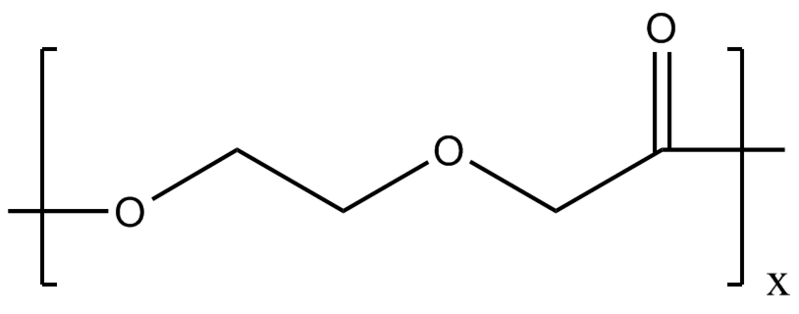
The molecular structure of one PDO molecule. This structure is repeated millions of times to make the length of polymer required for sutures. [3]https://commons.wikimedia.org/w/index.php?curid=61768464
The repeating units give PDO a long chain-like composition. This gives it the string-like property necessary for use as a suture. It is strong enough to tolerate mechanical tension but weak enough to degrade in human tissue.
The esters and oxygen bridges in the chain ensure that it is chemically weak enough to be degraded by the body. This makes it different from other plastic polymers (such as nylon) that lack this trait. [4]https://link.springer.com/chapter/10.1007/978-3-319-12478-0_2
But what exactly does the evidence say about its safety?
Is polydioxanone safe?
PDO is a unique type of polyester. It is very safe when compared to older polyesters. It was specifically developed to be safe because the medical field needed a type of suture that would not stimulate the immune system or cause localized reactions. [5]https://www.ncbi.nlm.nih.gov/pmc/articles/PMC7044756/
A systematic review of PDO revealed that it is the least detrimental compared to other polymers. Researchers say that it is the least antigenic, meaning the least likely to be attacked by the immune system [6]https://www.ncbi.nlm.nih.gov/pmc/articles/PMC7044756/
However, it is possible that some breakdown products of PDO can lower local pH. This is because some of the products are acidic, like propylene glycol, 2-hydroxyacetic acid, and glyoxylic acid.
This creates two hypothetical situations that are undesirable:
-
- Lower pH causes mild hypoxia that can stimulate the immune system
-
- Lower pH might stimulate the production of DHT, since the type II isoform of the 5-alpha reductase enzyme works best at a slightly acidic pH[7]https://pubmed.ncbi.nlm.nih.gov/7439118/
However, to our knowledge, these hypotheticals have not yet been reported. It is possible that the slow rate of degradation of PDO equates to a slow flux of breakdown products. If that is true, the effects on pH are minimal.
Caution with PDO hair treatment therapy
There are some important points to consider when utilizing PDO threading. It is recommended to reduce the amount of mechanical stress in the area where the procedure is done. Excess stress to the site of PDO threading will enact microstructural cracks in the tissue around the threads. This will increase the rate of degradation, increasing the flux of breakdown products. [8]https://www.ncbi.nlm.nih.gov/pmc/articles/PMC7044756/
Therapies like scalp massage, microneedling, PRP, and mesotherapy injections may therefore increase the rate of PDO breakdown, reducing the pH more than normal and causing an unwanted inflammatory response.
Metabolic rate is also known to affect the rate of breakdown. [9]https://www.ncbi.nlm.nih.gov/pmc/articles/PMC7044756/ Therefore, there may be unknown interactions for certain patients who:
- are taking thyroid medication
- have hypothyroidism
- or are taking any form of hormone replacement therapy
Finally, it is important to avoid injecting excess numbers of PDO monofilament threads. This is because PDO stimulates collagen expression from fibroblast cells. Too much or too strong a response to the procedure can initiate fibrotic tissue to form. Fibroblasts also express TGF-beta when making collagen. Together, these can worsen alopecia, so the right balance of PDO threads is necessary.
What is the evidence supporting PDO threads for hair growth?
Study of PDO by Bharti et al., (2017)
In the trial performed by Bharti et al., five males were enrolled to assess the effect of PDO monofilament threading. All participants were previously unresponsive to 10% minoxidil and finasteride (for over 18 months).
Three months before the trial, all participants stopped using their other therapies. Then 30mm long threads were inserted 1cm apart from each other into the dermis (below the epidermis). The maximum number of threads was between 20 – 40.
After 12 weeks, all participants had increases in hair count and expressed overall satisfaction with their hair when compared to baseline. The average hair follicle unit increase was by 67 HFU per cm2. Additionally, none of the participants had any adverse side effects except transient swelling. [10]https://onlinelibrary.wiley.com/doi/10.1111/jdv.14336
Study of polyglycolic acid coated gold threading by Kim et al., (2017)
Although the current narrative is about PDO, some other types of sutures are examined here for comparative purposes. In the study by Kim et al., one 38-year-old woman had polyglycolic acid-coated gold monofilament threading injected. This type of polyether is slightly different from PDO and is known to be slightly more antigenic than PDO. [11]https://www.ncbi.nlm.nih.gov/pmc/articles/PMC5792530/
A strand of polyglycolic acid was braided around gold threads that were 0.1mm in diameter. They were inserted into the hypodermal layer (lower skin layer). After 24 months, the participant’s results were assessed.

The participant saw a noticeable increase in hair, but the authors provided only photographs without measuring the changes. To explore variables and get quantifiable data, the authors tested the threads on mice.
They had four groups of mice for different treatments.
- Group one was given the negative saline control.
- Group two was given the polyglycolic acid thread.
- Group three was given the gold thread.
- Group four, the positive control group, was given 5% minoxidil with 200 microliter applications.
The thread lengths for both the gold group and the polyglycolic acid group were 2cm long. They were spaced apart by 0.5cm on the backs of the mice.
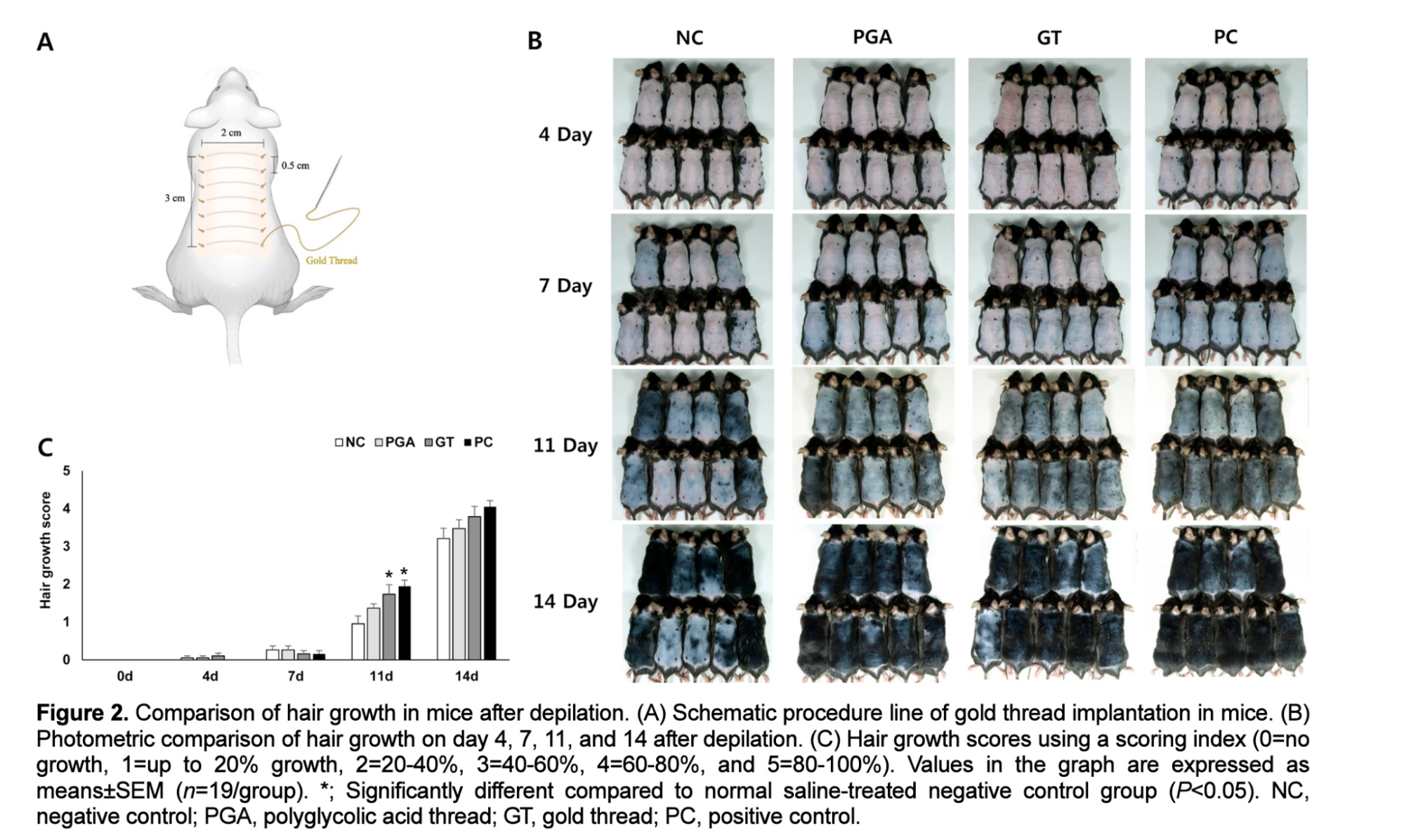
After 14 days, all three groups were better than the control at stimulating hair growth in mice.[13]https://synapse.koreamed.org/upload/synapsedata/pdfdata/0169lar/lar-33-291.pdf
Hair growth was the fastest in the gold and minoxidil group. But surprisingly, after doing histological analysis, the mice that received the polyglycolic acid threads had the highest number of hair follicles.
- PGA thread group had an increase of 111.56 +/- 2.35 hair follicles
- Gold thread group had an increase of 103.09 +/- 3.39 hair follicles.
- The 5% minoxidil group had an increase of 107.44 +/- 3.29 hair follicles.
- While the negative saline control group only had 87.51 +/- 2.63 hair follicle increase.
The study recognized that the gold thread and 5% minoxidil groups follow a different mechanism of hair growth compared to polyglycolic acid threads. Minoxidil and gold threads increased the expression of Ki67 and PCNA, which are markers for cellular proliferation.
However, the reason that polyglycolic acid increased the number of hair follicles was not explained. Nevertheless, the authors revealed why it is good to combine the gold threads with polyglycolic acid. It was because they do two separate things and work together.
Threading with polyglycolic acid only slightly promoted collagen formation.
But is collagen necessarily a bad thing?
Both the gold thread and the 5% minoxidil group were associated with a marked increase in the amount of collagen produced (in blue) in the dermis of the mice. The gold threading group showed the greatest increase, yet hair growth was strong.
The collagen that grew in the skin of mice was organized, not like scar tissue or fibrosis.
This clarifies that collagen is not necessarily associated with fibrosis or hair loss, especially if it is organized.
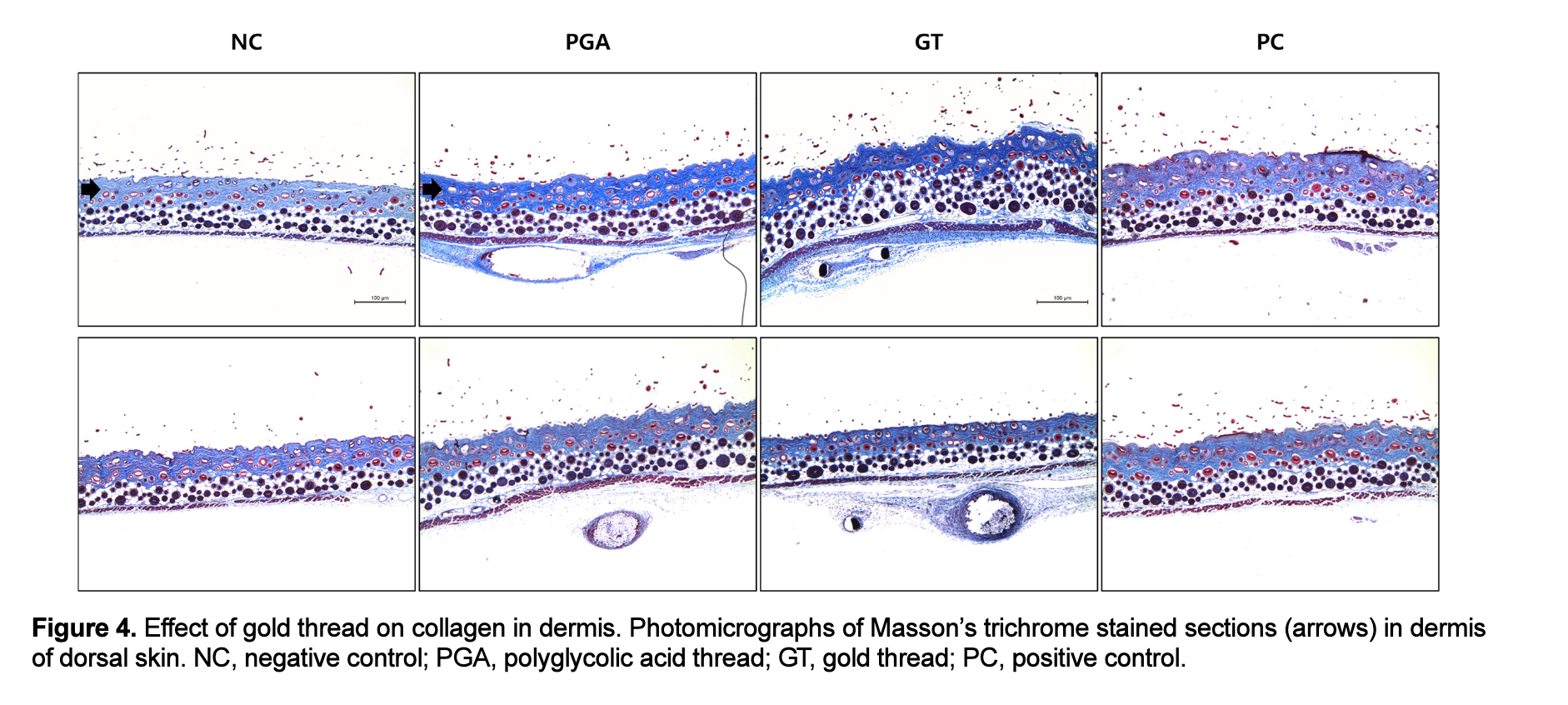
Study of poly-l-lactic acid threading by Khattab & Bessar (2019)
The study by Khattab & Bessar used poly-l-lactic acid (PLLA) threading to assess the improvement of androgenic alopecia in women. PLLA is a newer technology than PDO. It is regarded as an improvement, due to only breaking down into water, CO2, and lactic acid. [14]https://onlinelibrary.wiley.com/doi/10.1111/jocd.13228
CO2 is normal in the body, and so is lactic acid. In such small quantities, lactic acid is quickly converted by the cori cycle into glucose, or it feeds gluconeogenesis in the outer root sheath hair follicle cells (cells that line the follicle) to make energy for the hair follicle.
They tested PLLA on 28 women who had some degree of androgenic alopecia. They were only given the PLLA threading therapy on the right side of the scalp. They were then prescribed two daily 1mL applications of 2% minoxidil for six months, to be applied over the entire scalp.
A total of 8 threads of PLLA were given to each participant. The threads were 30mm in length and inserted 1cm apart. Similar to other studies, they were prescribed antibiotics and followed a 48-day mild shampooing regime.
When the minoxidil and threading were combined, patients experienced significant improvements. Furthermore, 25/27 patients observed improvement. Minoxidil alone also improved hair, but it was much less effective compared to the combined treatment.
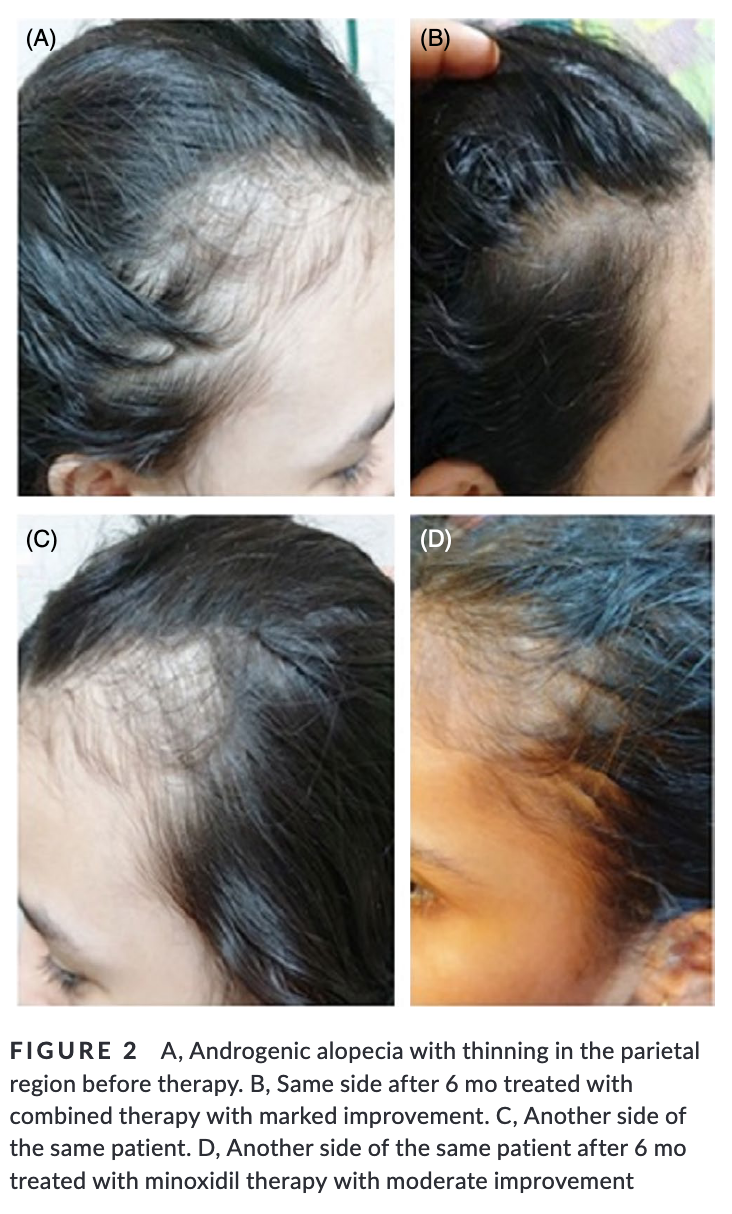
An example of one of the patients who received the combination therapy on the right side of the scalp, when compared to the minoxidil-only application on the left side of the scalp, saw much greater hair regrowth after six months. [15]https://onlinelibrary.wiley.com/doi/10.1111/jocd.13228

Another example of a patient who noticed similar improvements, far superior to minoxidil applications alone. [16]https://onlinelibrary.wiley.com/doi/10.1111/jocd.13228
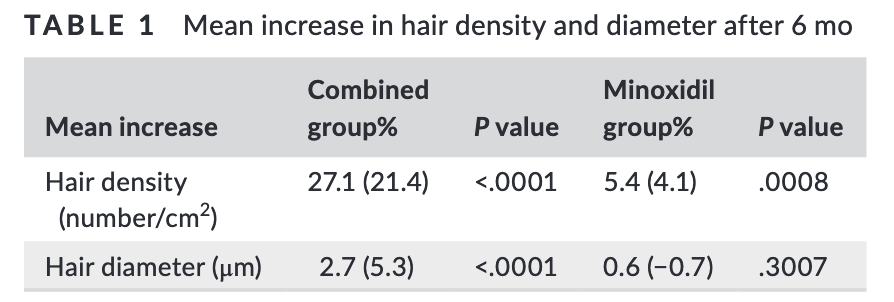
Results from trichoscopy demonstrated the improvement to hair density and diameter. The combination therapy was significantly better than the minoxidil therapy. [17]https://onlinelibrary.wiley.com/doi/10.1111/jocd.13228
When the researchers quantified their results using trichoscopy (to count hair number and the thickness of individual hair strands, it became obvious that the combination therapy that used both threading and minoxidil was far superior to minoxidil alone.
Threading has been shown to increase the expression of bromodeoxyuridine and proliferating nuclear antigen, two markers of active cellular proliferation.
According to this study, PLLA threading increases the expression of fibroblast growth factor (FGF)-7, while reducing FGF-5. FGF-7 promotes anagen growth (when follicles are actively growing), while FGF-5 halts anagen growth. [18]https://onlinelibrary.wiley.com/doi/10.1111/jocd.13228
Poly-l-lactic acid threading with placebo group by Metwalli et al., (2019)
In another study that assessed the efficacy of PLLA, 28 women with androgenic alopecia were equally split into a therapy and placebo group in a randomized controlled trial.
In the treatment group, 15 PLLA threads (27G, 60mm) were inserted 1cm2 apart, while the control group received a saline injection. After 26 weeks, the participants were assessed using hair counts, hair mass index and a general survey.
Over 70% of patients in the treatment group saw an improvement, while 70% in the placebo group saw no improvement. The results were highly statistically significant. [19]https://pubmed.ncbi.nlm.nih.gov/31619089/
Combining PDO with platelet-rich fibrin, by Bansod et al., (2020)
Bansod et al., combined PDO monofilament threading with platelet-rich fibrin injections (PRF). [20]https://www.longdom.org/open-access/combination-therapy-with-injectable-platelet-rich-fibrin-prf-and-polydioxanone-pdo-threads-in-treatment-of-male-pattern-.pdf
They injected a total of 2mL of PRF into the scalp skin, spread out into smaller volumes at intervals of 2cm apart. This was repeated approximately every six weeks, with up to 9 sessions in total.
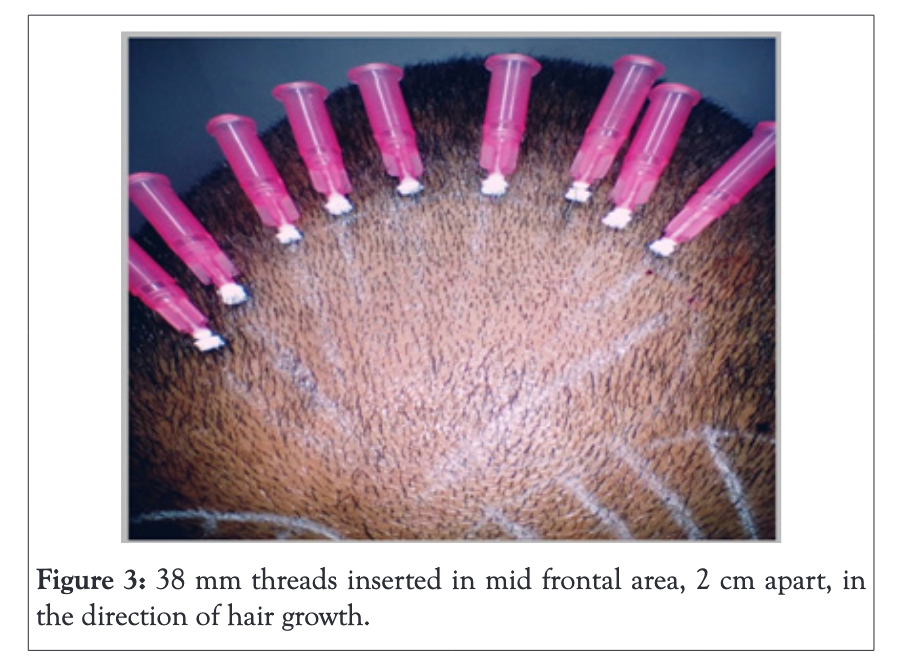
The PDO threads (29G, 38mm) were inserted 2 – 3 cm apart from one another. The authors covered all areas affected by AGA. Generally, this required 45 – 50 threads. The PDO therapy was performed only once every 6-8 months.
Patient One
The first patient received a single session of the PDO monofilament threading combined with PRF every six weeks, for a total of four sessions. The patient was also given 0.5mg of dutasteride orally and told to take it on alternate days.
Following the four sessions of PRF, there was an appreciable amount of hair growth in previously balding regions of the scalp.[22]https://www.ncbi.nlm.nih.gov/pmc/articles/PMC4812885/

Patient Two
The second patient had 30 PDO threads inserted in a single session combined with five sessions of PRF injections every six weeks.
Following the fifth session of PRF, there was again a great amount of hair regrown in previously balding regions of the scalp.

Patient Three
The third patient underwent a combination therapy of 5% minoxidil, five sessions of PRF, and two sessions of PDO monofilament threading spaced out once every six months. The patient, despite still undergoing the therapy, noticed most of their hair regrowth within the first five months. [23]https://www.longdom.org/open-access/combination-therapy-with-injectable-platelet-rich-fibrin-prf-and-polydioxanone-pdo-threads-in-treatment-of-male-pattern-.pdf

What does the evidence suggest?
The different types of monofilament threads were similar in their ability to promote hair regrowth. These consistent positive outcomes occurred regardless of the different study methods and patient demographics.
The evidence on PDO threading for hair growth is still preliminary. However, of the studies published (so far), there are signals warranting further study, particularly regarding the efficacy of PDO, or polyglycolic acid, or PLLA and their effects on human hair growth.
The mechanisms by which PDO threading might improve hair growth might not entirely overlap with the mechanisms suspected for minoxidil and/or microneedling. In particular, the differential increase of beneficial FGFs and decrease of contraindicated FGFs may be partly related to the mechanisms by which PDO threading improves hair parameters.
Based on the limited data so far, the therapy appears to be very safe. Among the studies published, no serious adverse events were reported by people receiving PDO threads for hair growth. The most notable side effects were local and transient inflammation that persisted for a couple of days after the procedures.
The potential of monofilament threading should be considered as an experimental treatment option for people with androgenic alopecia — provided that participants are aware of the small number of studies and low qualities of evidence supporting the intervention. For people interested in incorporating stimulation-based interventions into their hair growth routine, but who don’t like the 1-3 week frequencies of microneedling, monofilament threading might be an easier option — particularly as the procedure only needs to be conducted once every 6-8 months.
With that said, the convenience comes with lower levels of evidentiary support and a higher cost to patients. So, be aware of these things before signing up for the procedure.

Rob English is a researcher, medical editor, and the founder of perfecthairhealth.com. He acts as a peer reviewer for scholarly journals and has published five peer-reviewed papers on androgenic alopecia. He writes regularly about the science behind hair loss (and hair growth). Feel free to browse his long-form articles and publications throughout this site.
References
| ↑1, ↑14, ↑15, ↑16, ↑17, ↑18 | https://onlinelibrary.wiley.com/doi/10.1111/jocd.13228 |
|---|---|
| ↑2 | https://commons.wikimedia.org/wiki/File:Polydioxanone.png |
| ↑3 | https://commons.wikimedia.org/w/index.php?curid=61768464 |
| ↑4 | https://link.springer.com/chapter/10.1007/978-3-319-12478-0_2 |
| ↑5, ↑6, ↑8, ↑9 | https://www.ncbi.nlm.nih.gov/pmc/articles/PMC7044756/ |
| ↑7 | https://pubmed.ncbi.nlm.nih.gov/7439118/ |
| ↑10 | https://onlinelibrary.wiley.com/doi/10.1111/jdv.14336 |
| ↑11 | https://www.ncbi.nlm.nih.gov/pmc/articles/PMC5792530/ |
| ↑12, ↑13 | https://synapse.koreamed.org/upload/synapsedata/pdfdata/0169lar/lar-33-291.pdf |
| ↑19 | https://pubmed.ncbi.nlm.nih.gov/31619089/ |
| ↑20, ↑21, ↑23 | https://www.longdom.org/open-access/combination-therapy-with-injectable-platelet-rich-fibrin-prf-and-polydioxanone-pdo-threads-in-treatment-of-male-pattern-.pdf |
| ↑22 | https://www.ncbi.nlm.nih.gov/pmc/articles/PMC4812885/ |
